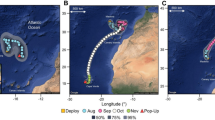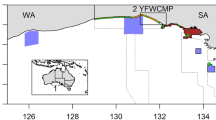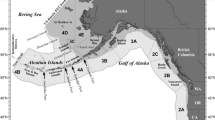Abstract
We examined movements of Atlantic blue marlin (Makaira nigricans) from the Gulf of Mexico based upon 42 pop-up archival transmitting (PAT) tags. Long deployments (including one 334-day track) revealed diverse movement patterns within the Gulf of Mexico. North–south seasonal changes in blue marlin distribution showed strong correspondence with established seasonal patterns of sea surface temperature and primary production. During the summer spawning season, blue marlin utilized outer shelf and shelf edge waters in the northern Gulf of Mexico, and longer duration tracks indicated overwintering habitats in the Bay of Campeche. Egress occurred throughout the year and was difficult to determine because some tracks ended in the Straits of Florida (n = 3) while other tracks recorded movement through it or the Yucatan Channel (n = 4). Our results indicate that Atlantic blue marlin have a more restricted geographic range of habitats than previously recognized and that the Gulf of Mexico provides spatially dynamic suitable habitat that is utilized year-round through seasonal movements.





Similar content being viewed by others
Notes
Regional fishery management organizations such as the International Commission for the Conservation of Atlantic Tunas (ICCAT) are charged with assessment, monitoring, and management of these resources.
ICCAT reported estimates of catch in tons from the western North Atlantic based upon spatially aggregated (5-degree intervals of latitude and longitude) data from all gear types. See Task II CATDIS data for tunas and tuna-like species posted at: http://www.iccat.int/en/accesingdb.htm.
References
Adam MS, Sibert J, Itano D, Holland K (2003) Dynamics of bigeye (Thunnus obesus) and yellowfin (T. albacares) tuna in Hawaii’s pelagic fisheries: analysis of tagging data with a bulk transfer model incorporating size-specific attrition. Fish Bull 101:215–228
Berthold P (2001) Bird migration: a general survey. Oxford University Press, Oxford
Block BA, Booth D, Carey FG (1992) Direct measurement of swimming speeds and depth of blue marlin. J Exp Biol 166:267–284
Block BA, Teo SLH, Walli A, Boustany A, Stokesbury MJW, Farwell CJ, Weng KC, Dewar H, Williams TD (2005) Electronic tagging and population structure of Atlantic bluefin tuna. Nature 434:1121–1127
Brill RW, Lutcavage ME (2001) Understanding environmental influences on movements and depth distributions of tunas and billfishes can significantly improve population assessments. Am Fish Soc Symp 25:179–198
Brinson AA, Alcala A, Die DJ, Shivlani M (2006) Contrasting socioeconomic indicators for two fisheries that target Atlantic billfish: Southeast Florida recreational charter boats and Venezuelan artisanal gill-netters. Bull Mar Sci 79:635–645
Buonaccorsi VP, McDowell JR, Graves JE (2001) Reconciling patterns of inter-ocean molecular variance from four classes of molecular markers in blue marlin (Makaira nigricans). Mol Ecol 10:1179–1196
Castro-Santos T, Haro A (2003) Quantifying migratory delay: a new application of survival analysis methods. Can J Fish Aquat Sci 60:986–996
Chaprales W, Lutcavage M, Brill R, Chase B, Skomal G (1998) Harpoon method for attaching ultrasonic and “popup” satellite tags to giant bluefin tuna and large pelagic fishes. Marine Technol Soc J 32:104–105
Chesney EJ, Baltz DM, Thomas RG (2000) Louisiana estuarine and coastal fisheries and habitats: perspectives from a fish’s eye view. Ecol Appl 10:350–366
Cox DR, Oakes D (1984) Analysis of survival data. Chapman and Hall, New York
Dagg MJ, Breed GA (2003) Biological effects of Mississippi River nitrogen on the northern gulf of Mexico—a review and synthesis. J Mar Syst 43:133–152
Dagg M, Benner R, Lohrenz S, Lawrence D (2004) Transformation of dissolved and particulate materials on continental shelves influenced by large rivers: plume processes. Cont Shelf Res 24:833–858
de Sylva DP, Breder PR (1997) Reproduction, gonad histology, and spawning cycles of North Atlantic billfishes (Istiophoridae). Bull Mar Sci 60:668–697
Devine B, Simms J, Holt S, Rooker J (2008) Age and growth of larval blue marlin (Makaira nigricans) from the northern Gulf of Mexico. Proc Gulf Caribb Fish Inst 60:638
Diaz GA, Ortiz M (2006) Updated white marlin (Tetrapturus albidus) and blue marlin (Makaira nigricans) catch rates from the U.S. recreational tournament fishery in the northwest Atlantic and the U.S. Gulf of Mexico 1973–2004. ICCAT Coll Vol Sci Paps 59:182–195
Die DJ (2006) Are Atlantic marlins overfished or endangered? Some reasons why we may not be able to tell. Bull Mar Sci 79:529–543
Domeier ML, Kiefer D, Nasby-Lucas N, Wagschal A, O’Brien F (2005) Tracking Pacific bluefin tuna (Thunnus thynnus orientalis) in the northeastern Pacific with an automated algorithm that estimates latitude by matching sea-surface-temperature data from satellites with temperature data from tags on fish. Fish Bull 103:292–306
Erdman DS (1968) Spawning cycle sex ratio and weights of blue marlin off Puerto Rico and Virgin islands. Trans Am Fish Soc 97:131–137
Fromentin JM, Powers JE (2005) Atlantic bluefin tuna: population dynamics, ecology, fisheries and management. Fish Fish 6:281–306
Goodyear CP (1999) An analysis of the possible utility of time-area closures to minimize billfish bycatch by US pelagic longlines. Fish Bull 97:243–255
Goodyear CP, Luo JG, Prince ED, Hoolihan JP, Snodgrass D, Orbesen ES, Serafy JE (2008) Vertical habitat use of Atlantic blue marlin, Makaira nigricans: interaction with pelagic longline gear. Mar Ecol Prog Ser 365:233–245
Graves JE (1998) Molecular insights into the population structures of cosmopolitan marine fishes. J Hered 89:427–437
Graves JE, Luckhurst BE, Prince ED (2002) An evaluation of pop-up satellite tags for estimating postrelease survival of blue marlin (Makaira nigricans) from a recreational fishery. Fish Bull 100:134–142
Gunn JS, Block BA (2001) Advances in acoustic, archival, and satellite tagging of tunas. In: Block BA, Stevens ED (eds) Tuna: physiology, ecology and evolution. Academic Press, San Francisco
Hill RD, Braun MJ (2001) Geolocation by light levels—the next step latitude. In: Sibert JR, Nielsen JL (eds) Electronic tagging and tracking in marine fisheries. Kluwer Academic Publishers, Boston, pp 315–330
Holland K, Brill R, Chang RKC (1990) Horizontal and vertical movements of pacific blue marlin captured and released using sportfishing gear. Fish Bull 88:397–402
Hosmer DW, Lemeshow S (1999) Applied survival analysis: regression modeling of time to even data. John Wiley & Sons, Inc., New York
Hunter JR, Lo NCH (1993) Ichthyoplankton methods for estimating fish biomass introduction and terminology. Bull Mar Sci 53:723–727
Jonsson B, Jonsson N (1993) Partial migration—niche shift versus sexual-maturation in fishes. Rev Fish Biol Fish 3:348–365
Kafatos M, Sun D, Gautam R, Boybeyi Z, Yang R, Cervone G (2006) Role of anomalous warm gulf waters in the intensification of Hurricane Katrina. Geophys Res Lett 33:L17802
Kaitala A, Kaitala V, Lundberg P (1993) A theory of partial migration. Am Nat 142:59–81
Kalman RE (1960) A new approach to linear filtering and prediction problems. Transactions of the American Society of Mechanical Engineers. J Basic Eng 82(Series D):35–45
Kerstetter DW, Luckhurst BE, Prince ED, Graves JE (2003) Use of pop-up satellite archival tags to demonstrate survival of blue marlin (Makaira nigricans) released from pelagic longline gear. Fish Bull 101:939–948
Kraus RT, Rooker JR (2007) Patterns of vertical habitat use by Atlantic blue marlin (Makaira nigricans) in the Gulf of Mexico. Gulf Caribb Res 19:89–97
Kraus RT, Secor DH (2004) Dynamics of white perch Morone americana population contingents in the Patuxent River estuary, Maryland, USA. Mar Ecol Prog Ser 279:247–259
Lam CH, Nielsen A, Sibert JR (2008) Improving light and temperature based geolocation by unscented Kalman filtering. Fish Res 91:15–25
Lohrenz SE, Wiesenburg DA, Arnone RA, Chen X (1999) What controls primary production in the Gulf of Mexico? In: Kumpf H, Steidinger K, Sherman K (eds) The Gulf of Mexico large marine ecosystem: assessment, sustainability, and management. Blackwell Science, Inc., Massachusetts, pp 151–170
Luckhurst BE (2003) Historical development of recreational billfishing in Bermuda and the significance of catches of large blue marlin (Makaira nigricans). Mar Freshw Res 54:459–462
Lutcavage ME, Brill RW, Skomal GB, Chase BC, Howey PW (1999) Results of pop-up satellite tagging of spawning size class fish in the Gulf of Maine: do North Atlantic bluefin tuna spawn in the mid-Atlantic? Can J Fish Aquat Sci 56:173–177
Luthy SA, Cowen RK, Serafy JE, McDowell JR (2005) Toward identification of larval sailfish (Istiophorus platypterus), white marlin (Tetrapturus albidus), and blue marlin (Makaira nigricans) in the western North Atlantic Ocean. Fish Bull 103:588–600
Majkowski J (2007) Global fishery resources of tuna and tuna-like species. FAO, Rome
Mather FJ, Beardsle Gl, Jones AC (1972) Migration and distribution of white marlin and blue marlin in Atlantic Ocean. Fish Bull 70:283–298
Muller-Karger FE, Walsh JJ, Evans RH, Meyers MB (1991) On the seasonal phytoplankton concentration and sea-surface temperature cycles of the Gulf of Mexico as determined by satellites. J Geophys Res Oceans 96:12645–12665
Musyl MK, Brill RW, Curran DS, Gunn JS, Hartog JR, Hill RD, Welch DW, Eveson JP, Boggs CH, Brainard RE (2001) Ability of electronic archival tags to provide estimates of geographical position based on light intensity. In: Sibert JR, Nielsen JL (eds) Electronic tagging and tracking in marine fisheries. Kluwer Academic Publishers, Boston, pp 315–330
Nielsen A, Bigelow KA, Musyl MK, Sibert JR (2006) Improving light-based geolocation by including sea surface temperature. Fish Oceanogr 15:314–325
Nishikawa Y, Kikawa S, Honma M, Ueyanagi S (1978) Distribution atlas of larval tunas, billfishes, and related species—results of larval surveys by R/V Shunyo Maru and Shoyo Maru 1956-1975. Far Seas Fisheries Research Laboratory S Series 9:1–99 (in Japanese, English summary)
Ohlmann JC, Niiler PP, Fox CA, Leben RR (2001) Eddy energy and shelf interactions in the Gulf of Mexico. J Geophys Res Oceans 106:2605–2620
Orbesen ES, Hoolihan JP, Serafy JE, Snodgrass D, Peel EM, Prince ED (2008) Transboundary Movement of Atlantic istiophorid billfishes among international and U.S. domestic management areas inferred from markrecapture studies. Mar Fish Rev 70:14–23
Ortiz M, Prince ED, Serafy JE, Holts DB, Davy KB, Pepperell JG, Lowry MB, Holdsworth JC (2003) Global overview of the major constituent-based billfish tagging programs and their results since 1954. Mar Freshw Res 54:489–507
Prince ED, Goodyear CP (2006) Hypoxia-based habitat compression of tropical pelagic fishes. Fish Oceanogr 15:451–464
Prince ED, Lee DW, Zweifel JR, Brothers EB (1991) Estimating age and growth of young atlantic blue marlin, Makaira nigricans, from otolith microstructure. Fish Bull 89:441–459
Prince ED, Cowen RK, Orbesen ES, Luthy SA, Llopiz JK, Richardson DE, Serafy JE (2005) Movements and spawning of white marlin (Tetrapturus albidus) and blue marlin (Makaira nigricans) off Punta Cana, Dominican Republic. Fish Bull 103:659–669
Rezak R, Bright TJ, McGrail DW (1985) Reefs and banks of the northwestern Gulf of Mexico—their geological, biological, and physical dynamics. Wiley, New York
Richardson DE, Vanwye JD, Exum AM, Cowen RK, Crawford DL (2007) High-throughput species identification: from DNA isolation to bioinformatics. Mol Ecol Notes 7:199–207
Richardson DE, Cowen RK, Prince ED, Sponaugle S (2009) Importance of the Straits of Florida spawning ground to Atlantic sailfish (Istiophorus platypterus) and blue marlin (Makaira nigricans). Fish Oceanogr 18:402–418
Rooker JR, Bremer JRA, Block BA, Dewar H, de Metrio G, Corriero A, Kraus RT, Prince ED, Rodríguez-Marín E, Secor DH (2007) Life history and stock structure of Atlantic Bluefin Tuna (Thunnus thynnus). Rev Fish Sci 15:265–310
Rooker JR, Secor DH, De Metrio G, Schloesser R, Block BA, Neilson JD (2008) Natal homing and connectivity in Atlantic Bluefin Tuna populations. Science 322:742–744
Schroepfer RL, Szedlmayer ST (2006) Estimates of residence and site fidelity for red snapper Lutjanus campechanhus on artificial reefs in the northeastern Gulf of Mexico. Bull Mar Sci 78:93–101
Secor DH (1999) Specifying divergent migrations in the concept of stock: the contingent hypothesis. Fish Res 43:13–34
Secor DH, Kerr LA (2009) Lexicon of life cycle diversity in diadromous and other fishes. Am Fish Soc Symp 69:537–556
Serafy JE, Cowen RK, Paris CB, Capo TR, Luthy SA (2003) Evidence of blue marlin, Makaira nigricans, spawning in the vicinity of Exuma Sound, Bahamas. Mar Freshw Res 54:299–306
Sibert J, Hampton J (2003) Mobility of tropical tunas and the implications for fisheries management. Marine Policy 27:87–95
Sibert JR, Musyl MK, Brill RW (2003) Horizontal movements of bigeye tuna (Thunnus obesus) near Hawaii determined by Kalman filter analysis of archival tagging data. Fish Oceanogr 12:141–151
Sibert JR, Lutcavage ME, Nielsen A, Brill RW, Wilson SG (2006) Interannual variation in large-scale movement of Atlantic bluefin tuna (Thunnus thynnus) determined from pop-up satellite archival tags. Can J Fish Aquat Sci 63:2154–2166
Simms JR (2009) Early life ecology of sailfish, Istiophorus platypterus, in the northern Gulf of Mexico. M.Sc. Thesis. Texas A&M University, College Station
Squire JL (1987) Striped marlin, Tetrapturus audax, migration patterns and rates in the Northeast Pacific Ocean as determined by a cooperative tagging program: its relation to resource management. Mar Fish Rev 49:26–43
Sturges W (1993) The annual cycle of the western boundary current in the Gulf-of-Mexico. J Geophys Res Oceans 98:18053–18068
Sturges W, Blaha JP (1976) A western boundary current in the Gulf of Mexico. Science 92:367–369
Sturges W, Leben R (2000) Frequency of ring separations from the loop current in the Gulf of Mexico: a revised estimate. J Phys Oceanogr 30:1814–1819
Teo SLH, Boustany A, Blackwell S, Walli A, Weng KC, Block BA (2004) Validation of geolocation estimates based on light level and sea surface temperature from electronic tags. Mar Ecol Prog Ser 283:81–98
Theriault V, Dunlop ES, Dieckmann U, Bernatchez L, Dodson JJ (2008) The impact of fishing-induced mortality on the evolution of alternative life-history tactics in brook charr. Evol Appl 1:409–423
Toner M, Kirwan AD, Poje AC, Kantha LH, Muller-Karger FE, Jones C (2003) Chlorophyll dispersal by eddy-eddy interactions in the Gulf of Mexico. J Geophys Res Oceans 108:3105
Walsh JJ, Dieterle DA, Meyers MB, Mullerkarger FE (1989) Nitrogen exchange at the continental margin—a numerical study of the Gulf of Mexico. Prog Oceanogr 23:245–301
Welch DW, Eveson JP (1999) An assessment of light-based geoposition estimates from archival tags. Can J Fish Aquat Sci 56:1317–1327
Wells RJD, Rooker JR, Prince ED (2010) Regional variation in the otolith chemistry of blue marlin (Makaira nigricans) and white marlin (Tetrapturus albidus) from the western North Atlantic Ocean. Fish Res 106:430–435
Wilson CA, Dean JM, Prince ED, Lee DW (1991) An examination of sexual dimorphism in Atlantic and Pacific blue marlin using body-weight, sagittae weight, and age estimates. J Exp Mar Biol Ecol 151:209–225
Wilson J, Rilling C, Defosse J, Brewster-Geisz K (2007) Temporal and spatial analyses of pelagic longline time/area closures in the Gulf of Mexico to reduce discards of bluefin tuna. ICCAT Coll Vol Sci Paps 60:1179–1236
Witzell WN, Scott EL (1990) Blue marlin, Makaira nigricans, movements in the western North Atlantic ocean: results of a cooperative game fish tagging program, 1954–88. Mar Fish Rev 52:12–17
Worton BJ (1989) Kernel methods for estimating the utilization distribution in home range studies. Ecology 70:164–168
Acknowledgments
We are grateful for the participation of the captains and crew of the sport fishing vessels in the tagging work, especially Bill Lyons, Mark Lyons, John Cochrane, and Brett Falterman. In addition, we thank Anders Nielsen and Tim Lam for their assistance with the state-space model programs. We are also grateful for comments of an anonymous reviewer, which greatly improved the manuscript. The tagging research was funded by awards to J.R.R. from the McDaniel Charitable Foundation. R.J.D.W. was supported in part by a Texas Institute of Oceanography (TIO) postdoctoral research fellowship. R.T.K. was supported by a TIO postdoctoral fellowship and a faculty development leave award from George Mason University.
Author information
Authors and Affiliations
Corresponding author
Additional information
Communicated by D. Righton.
Appendix
Appendix
See Table 2.
Rights and permissions
About this article
Cite this article
Kraus, R.T., Wells, R.J.D. & Rooker, J.R. Horizontal movements of Atlantic blue marlin (Makaira nigricans) in the Gulf of Mexico. Mar Biol 158, 699–713 (2011). https://doi.org/10.1007/s00227-010-1593-3
Received:
Accepted:
Published:
Issue Date:
DOI: https://doi.org/10.1007/s00227-010-1593-3




